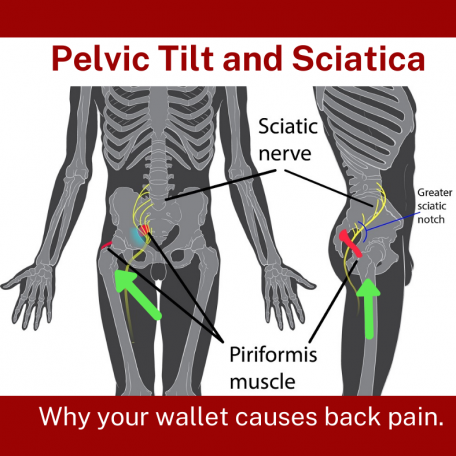
Why Your Wallet Is Causing You Back Pain And What You Can Do About It
Do you know why your wallet is causing you back pain? We are here to explain the why’s, the remedies and how to fix it. If you already suffer from back pain and sciatica, read on.
Stop Sitting On Your Wallet
Tons of guys carry their wallets in their back pockets. They can reach back, it’s easy to grab, the forever go-to spot for storing their stuff. But carrying that fat wad of cash in your pocket can lead to serious issues. Your wallet is causing muscle imbalances and nerve irritation, affecting your pelvis, hips and back.
Pelvic Tilt
Once you sit, the extra height added by your wallet throws your hips and pelvis out of alignment. The imbalacement caused by your wallet can affect nearly every part of your body. With your spine being attached to your pelvis, that extra lift and tilt of the pelvis pushes the spine out of its natural position. The thicker the wallet, the more tilt added to your pelvis.
Stressed Spine
Imagine walking with one bare foot and the other foot in a thick-soled shoe. You would be lopsided, right? Same idea with that bulky billfold which forces your pelvis to shift to one side. Over time, this postural stress can contribute to disc herniation, spinal degeneration, and low back pain.
Wallet Neuropathy
The term “wallet neuropathy” dates back to 1965. Experts expressed, even back then, a surge in “wallet neuropathy” as men damaged nerves by sitting on wallets stored in their back pockets. To this day, physical therapists use this term, along with “fat wallet syndrome”. It is a painful condition that can lead to aches or numbness radiating down the hip, leg, or foot. “I sat on my wallet during a nine-hour drive. I had not been to the bank, so my wallet was stuffed. I landed in urgent care, in pain, not long after my arrival. Because I sat on my wallet, I aggravated my sciatic nerve”. For Jeremy, the recovery has been difficult. He has since seen his doctor and is in physical therapy twice a week.
Simple Solutions
Achieve pain-free wallet storage with these ideas:
- Declutter and downsize. Swap your current wallet for a thin version which will keep you from shoving too much junk in it. It will fit perfectly in your shirt pocket.
- Opt for a money clip which is small and conveniently pain-free.
- Store your wallet anywhere but your pant pocket. Seriously! Try: Coat pocket, briefcase or your backpack.
- Store your wallet in your desk while at the office.
- When driving, place it in the center console.
- Carry a sling bag to store your wallet.
- Sit less. Couldn’t help it, this advice is good!
Stretches To Relieve Sciatica Pain
Suffering from sciatic nerve pain can be brutal, however, there are stretches you can do to help release tension. These stretches release tightness in the piriformis muscle, in the glute area, the same proximity as the sciatic nerve. When tight, the piriformis muscle can press on the sciatic nerve. Regular daily stretching can save you from living with back pain or from reoccurring sciatica pain.
If you are cleared by you doctor to stretch, start with these 4 stretches listed below:
Sitting Pigeon Pose
Sit on the floor, with your back straight and your legs straight in front of you. Bend your right leg, putting your right ankle on top of the left knee. Lean forward and allow your upper body to reach toward your toes for 20 to 30 seconds. Repeat on the other side.
Seated Hip Stretch
Sit in a chair with your feet on the floor and knees bent at a 90-degree angle. Raise the right leg up and cross that ankle over the left knee. Gently bend forward over the crossed leg, hold 20 to 30 seconds. Repeat on the other side.
Knee To Opposite Shoulder
Lie on your back with your legs extended. Bend your right leg and clasp your hands around the knee. Gently pull your right leg across your body toward your left shoulder. Hold it there for 20 to 30 seconds. Pull only as far as comfortable. Return to start position. Repeat on the other side.
Hamstring Stretch
Lie on your back with a stretch strap or resistance band around the ball of your right foot. If you don’t have one, use your hands to pull back on your thigh instead. Gently stretch your right leg up while keeping the opposite leg flat on the floor. Keep both knees straight. Hold 20 to 30 seconds. Return to the starting position and repeat on the opposite side.
20% off
use coupon code:
get20

